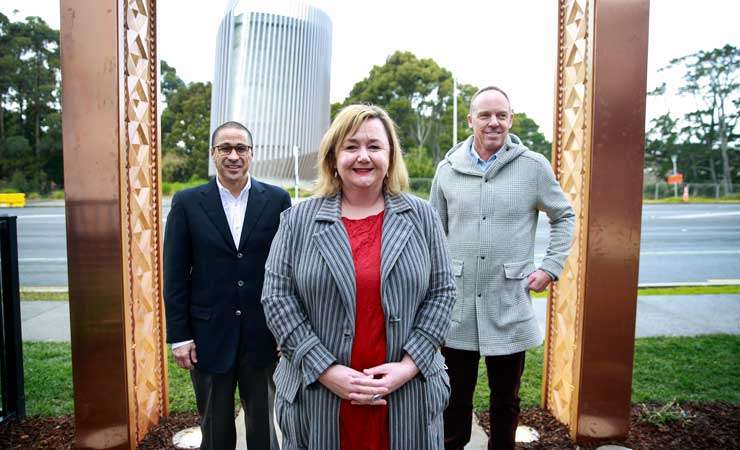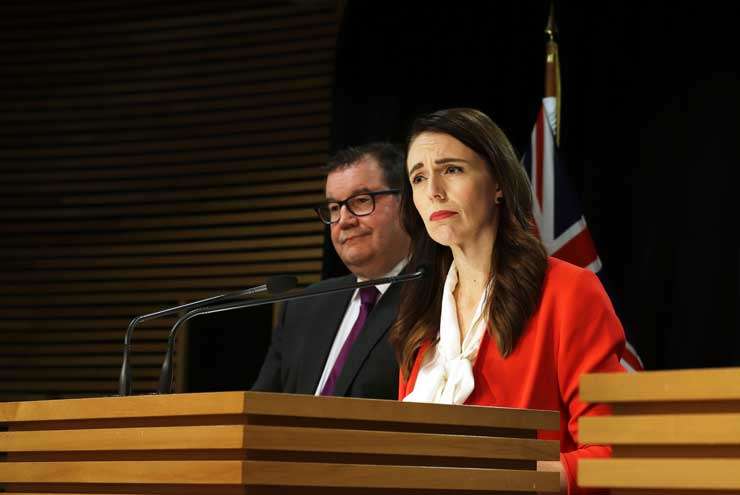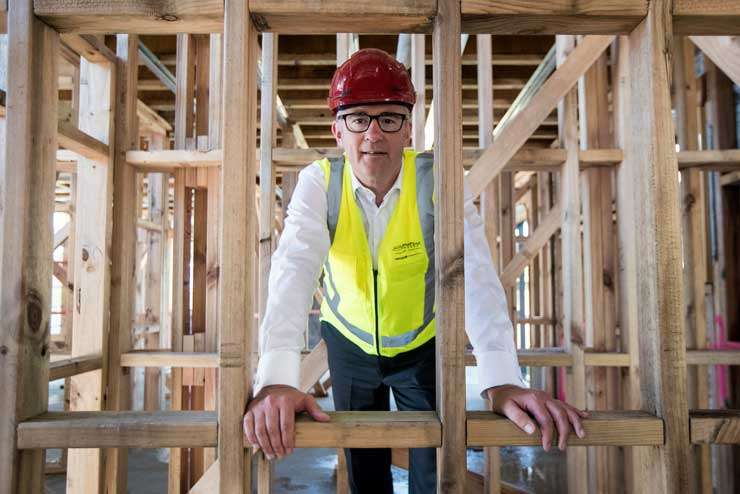The housing crisis has been a long time in the making but tens of thousands of new homes are coming, says Housing Minister Megan Woods.
“Let’s be clear, the housing crisis is a result of decades of inaction, where it was assumed the market would meet the demand for more new affordable homes. Not surprisingly, it didn’t.”
Building consents “fell off a cliff” after the Global Financial Crisis (2008) and nothing was done to stimulate affordable housing, Woods said in a written response to OneRoof questions. “As a result, New Zealand has a severe housing shortfall and multiple interventions are needed to increase new development, particularly for affordable homes.”
Cutting red tape to allow more housing density in urban areas is key to boosting new housing, she says. “PWC estimates the changes we are making, with support from the National Party - the Resource Management (Enabling Housing Supply and Other Matters) Amendment Bill - will result in at least 48,200 and as many as 105,500 new homes in the next five to eight years.
Start your property search
“This is in addition to an anticipated 72,000 homes built over about the next 20 years as a result of changes we made last year through the National Policy Statement – Urban Development.
“There’s no silver bullet to the housing crisis but significantly boosting the number of new homes is critical, and this will take more time.”
Woods says house prices have risen on the back of low supply and rock-bottom interest rates, a situation that is changing and is likely to impact investors. “Early on, our Government moved to restrain housing speculation with the foreign buyer ban. The new interest deductibility rules to shift investors away from residential property have a deliberate exclusion to encourage investment in new housing.”
Green shoots of positive change are now being seen, she says. “Price rises appear to be stabilising and the number of first-home buyers is growing. There is an enormous amount of building activity in the market, with new dwelling consents breaking records for several months in a row. This trend remains strong.”

Woods at the opening of a new apartment block in Auckland's Waterview in June this year. Photo / Alex Burton
While Woods is positive about the crisis improving, two economists spoken to for this story give the Government’s housing performance only a pass mark. Nick Tuffley, the ASB’s chief economist, gives 8/9 out of 10 for enthusiasm and passion for Labour’s recognition of the problem and willingness to attack it, but only a 5 for execution. Brad Olsen, principal economist and director of Infometrics, gives an overall six out of 10, saying the score could be worse – but it could be better.
“I think [it] only just scrapes through on the edge of doing enough. In all honesty, my score would have been different if they hadn’t talked such a big game – people were expecting this housing crisis business to be fixed by now. It’s now substantially worse.”
Labour came to power in 2017 looking to shake up the housing market. Among the measures implemented was the overseas buyer ban, but while they looked closely at a capital gains tax Prime Minister Jacinda Ardern went on to rule one out under her watch.
Labour has, however, twice extended the bright line test, first brought in under National, which is like a mini-capital gains tax.
Arguably Labour’s biggest misstep was its flagship KiwiBuild scheme, which had promised 100,000 affordable homes over 10 years but which fell woefully short. The target was abandoned altogether when Woods took over the housing portfolio from the embattled Phil Twyford in 2019.

Prime Minister Jacinda Ardern and Finance Minister Grant Robertson announce the Government's housing new housing policy in March 2021. Photo / Getty images
In a “reset” of the scheme, KiwiBuild, along with Housing New Zealand, was put into the jurisdiction of the newly-formed Kāinga Ora – Homes and Communities, which is tasked with being the public housing landlord and also partnering with developers, iwi and communities on urban development projects.
Last year saw the arrival of Covid, record low mortgage rates and other monetary policy measures from the Reserve Bank to stave off economic collapse, but house prices rose.
Earlier this year, the Government announced a housing package that was designed to “curb rampant speculation” and “tilt the balance” of the market towards first-home buyers.
The measures included extending the bright line test from five to 10 years and the phasing out of property investors’ ability to claim interest on loans as an expense.
There were also increases to first home grants and a lifting of house price caps, and $3.8 billion was allocated to a Housing Acceleration Fund to pay for infrastructure.
This year also saw letters sent to the Reserve Bank by Finance Minister Grant Robertson asking the bank to take house prices into account when looking at monetary policy. After Governor Adrian Orr rejected that, Robertson directed the bank to take into account the Government’s objective to support more sustainable house prices.
The Government has also approved in principle that the bank can use debt-to-income ratios to ensure sustainable house prices, as long as the impact on first-home buyers is minimised.

Former Housing Minister Phil Twyford inspects a KiwiBuild development. Labour's pledge to 100,000 affordable homes fell woefully short. Photo / Supplied
July this year also saw the announcement of the National Policy Statement - Urban Development, which directs councils to free up land around transport hubs, while in October there was the surprise joint announcement by Labour and National on the Housing Supply Bill which will allow three homes of up to three-storeys high to be built on most sites without the need for resource consent.
Tuffley says improving the supply of homes has been a long-term challenge since the Reserve Management Act (RMA) came into play in 1991. Heavily regulated jurisdictions around the world tend to have higher house prices, he says, and since the RMA the cost of land and building has escalated, along with time frames around consents. The Government is addressing the RMA but the jury is out on how effective its plans to split the Act into three will be.
But Labour has pushed hard try to resolve the supply side of the housing equation, Tuffley says, and while the original KiwiBuild scheme didn’t work, the plan had been to flood the market with new homes at the lower cost end of the market, where developers weren’t building.

ASB chief economist Nick Tuffley gives Labour 8/10 for enthusiasm but 5/10 for execution. Photo / Supplied
“With the benefit of hindsight, it was more of a solution that got proposed without probably looking at what the actual problem was - hence it ran into all the problems that were fundamentally there.”
Those include land being scarce and expensive, as well as the difficulty, expense and time taken to get consents, plus infrastructure problems.
Tuffley thinks the joint announcement is progress as it gets rid of a lot of the red tape that has stopped infill development.
Probably the most significant step this year was the removal of interest deductibility, which impacts investors’ cashflow but means residential property is being treated differently to any other investment with tax deductible expenses.
What has been missing is a fast-enough supply response, but to give the Government credit it is working hard on creating more supply of social housing, he says.
Overall, Labour recognised housing as an issue before it came to government and had an “absolute will to do a heck of a lot more about it… but it has been the execution of the ideas which haven’t necessarily been as effective as people would have liked,” says Tuffley.

Economist Brad Olsen: "People were expecting this housing crisis business to be fixed; it’s now substantially worse.” Photo / Tania Whyte
Olsen points to a lot of tinkering on the demand side, saying measures like the foreign buyer ban “was always a convenient political beat-up rather than a solid housing market change”.
And while the change to interest deductibility was presented as a tax loophole, it wasn’t one – “I mean, if that’s a tax loophole then the way we do business is a tax loophole because it is literally how you do business.”
But while investors have said they would leave the market because of the change, Olsen notes that they haven’t, saying housing is their bread and butter.
Some positives have started to come through.
Olsen praises the National Policy Statement - Urban Design, saying Labour has given more clear directives here than New Zealand has been used to, but says it has been challenging at times to understand how the Government and the Reserve Bank separately see how the Bank fits into the housing sector.
One of New Zealand’s greatest housing policy failures is not having a central focus on housing, Olsen says.
“We have a Ministry of Housing and Urban Development (HUD) but we also have housing policy that is very tightly controlled between Treasury, the Reserve Bank, MBIE, HUD, Kāinga Ora, MSD – you have a real alphabet soup with no over-arching co-ordination and, therefore, some really difficult mixed messages that are just not helpful in that environment.”










